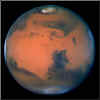It's red. It's big. It's bad. It's MARS.
The Greeks called the planet Ares; the Romans gave it the name-Mars. Who cares? It meant the same thing: the god of war.
Mars is the last of the inner planets. A little more then half of the size of Earth, it orbits the Sun at a distance, that is, half of the distance of Earth's distance from the Sun. Once every 780 days Earth and Mars make side-by-side approaches, called oppositions. The closest opposition occur every 15 or 17 years. A telescope at that time could show many surface markings on Mars, when seeing conditions were good.
Since Mars was formed in the region of the original solar disk that formed Earth, it evolved compounds like those on Earth. The Martian soil is mostly made out of the elements-silicon, and oxygen combined with varying amounts of metallic elements that include iron and magnesium. Iron oxide is the element that gives Mars it's reddish colour. Sometimes clouds of this reddish dust and sand are swept up by fierce summer winds in Mars's Southern Hemisphere. Sometimes most or all of the planet gets covered by this dust. Like Earth, Mars has a primitive Atmosphere by venting gases from hot interiors. Such gases include carbon dioxide, carbon monoxide, methane, nitrogen, hydrogen, and water vapor. Today the Martian atmosphere is mostly carbon dioxide, with as much as 30% argon and only 0.01% water vapor. The Martian atmosphere also contains trace amounts of ozone and hydrogen.

